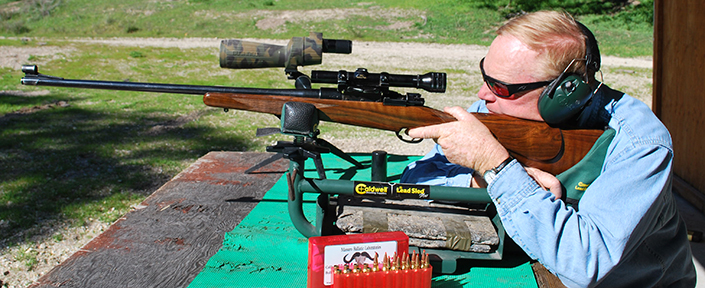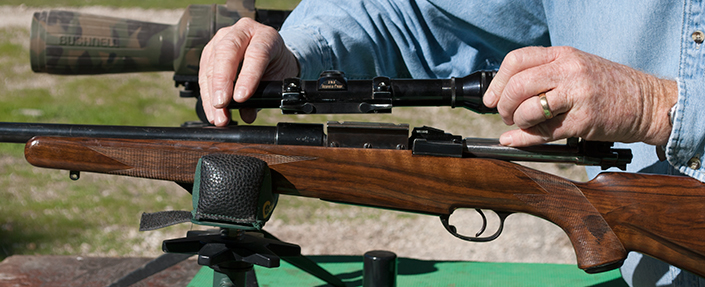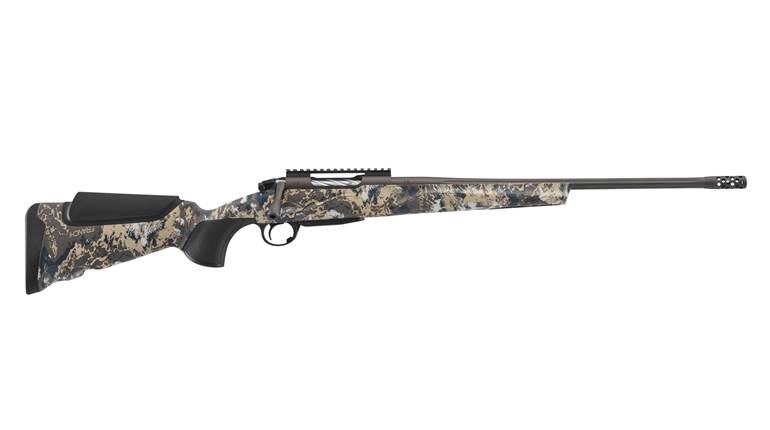
John H. Batten’s commercial Mauser (above), while conventional in appearance for its era, held a few surprises for the author who, decades later, came to own it.
The notation is simple and brief: “Mauser .30-.338 magazine rifle, no maker’s name—built by R.A. Wells, serial number 68XX—my favorite hunting rifle.” So wrote John Batten in a letter to his family detailing his firearms.
John H. Batten (1912-1989) was an American industrialist, the longtime chairman of Twin Disc in Racine, Wis. A lifelong hunter, he was a leader in the Boone and Crockett Club and a close friend to Jack O’Connor and my less-well-known uncle, Art Popham. He was also a nice guy; when I was a new kid on the block he befriended me and wrote a foreword for one of my early books. His hunting career was long and varied, spanning more than 60 years and encompassing much of the world as it was in his time. He chronicled his adventures in a trilogy published by Amwell Press: Skyline Pursuits, The Formidable Game and The Forest and the Plain (what great titles!).

He owned other rifles, and could have owned any rifle he wanted. In 1930, he started with a Griffin & Howe Springfield, and he was very fond of his Holland & Holland in .300 H&H Mag. As a Wisconsin whitetail hunter, he noted that his Winchester Model 71 in .348 Win. was “his favorite deer rifle.” The photos in his books show other rifles that are not remembered, but his last testament states that his .30-338 by R.A. Wells was his favorite.
Some time back I met his grandson, also John Batten, and just recently became the owner of this favored rifle. The checkering is smooth, the stock has honest scratches and dents, and some of the bluing is worn. But it’s a fascinating firearm because it yields amazing insight into what might have been a state-of-the-art hunting rifle a full generation ago.

The Times
The rifle is not dated, and I have yet to uncover any record of its maker, R.A. Wells. However, I think we can come close. Winchester introduced both the .264 and .338 Winchester Magnums in 1958. Wildcatters immediately necked down the .338 case to .30 caliber, creating the .30-338. Initially designed for 1,000-yd. competition, it quickly became a popular wildcat. Although it persisted in target circles (and is still seen today), as a hunting cartridge its reason for existence was greatly reduced when Winchester introduced its .300 Win. Mag. in 1963.
The two are in no way interchangeable; the .300 Win. Mag. has a slightly longer case and a much shorter neck in order to maximize powder capacity. The .30-338, with its full-caliber-length neck, was touted as a more accurate option, but is not quite as fast. The very similar .308 Norma Mag., introduced in 1960, was an attempt to standardize the several versions of a .30 caliber based on the .338 case, but with a slightly longer case and different shoulder it is not interchangeable with the wildcat .30-338. Although we cannot be certain, it is most likely that this rifle was built between 1958 and 1963, so for simplicity we’ll call it “circa 1960.”
At that time, the .300 H&H was the most popular “fast magnum,” although the .300 Wby. Mag. was gaining ground. Batten was doing a lot of mountain hunting, and he wanted a cartridge with some reach. But in 1960 the complete shift to telescopic sights had not been made, certainly not by hunters of Batten’s generation. Like his friend Jack O’Connor, Batten started mountain hunting in the 1930s, both using aperture sights. Only in the post-war era did scopes gain enough trust for general use, but the scopes employed in those days were far different from what we use today. Variable-power scopes were barely experimental and wouldn’t be trusted for another 20 years. O’Connor passed away in 1978, to the end maintaining that the fixed 4X was all anyone needed for big-game hunting. In 1960, the big-game scope was fixed in power with low magnification. Stocks were invariably wood and usually walnut; synthetic stocks for sporters wouldn’t be seen for another 15 years.

Action And Barrel
The action is a commercial Mauser with horizontal safety, vintage uncertain because action markings (if any) are hidden under the side scope mount. In those days, the Winchester Model 70 action was the darling of many affluent hunters, and it certainly was O’Connor’s favorite. The Mauser, however, was an alternate and popular choice, and certainly was the most familiar to Batten: His old Springfield was simply a Mauser clone, and the .300 H&H Mag. that preceded this rifle as his pet was almost certainly on a Mauser action. Like all Mausers, this rifle is smooth and positive, and certainly fully broken-in.
I’ll be honest: It could use some work. The ejector blade is worn, the follower spring is a bit weak and it has an intermittent “follow down” issue when the bolt is closed. No matter; until I took it to the range the rifle probably hadn’t been fired in 30 years, and it needs a session with a good Mauser mechanic.
The barrel is 24" long of medium contour, clean except for a barrel band front sight. Markings are simple: “.30-338” (note that lack of a period in front of 338) on the left side of the barrel shank. On the top center, just behind the fore-end tip, is inscribed “John H. Batten, Racine.” The right side of the barrel is clean, with the serial number on the right of the forward action ring. The rifling is worn, and throat erosion, though not severe, is obvious. John Batten shot this rifle a lot!
The blued metal is straightforward; a tried-and-true action mated to what was undoubtedly once a very good barrel. There are two other aspects to this rifle that I find especially fascinating. The .30-338 cartridge dates the rifle, but it’s the sighting equipment that makes it a time capsule, and the stock presents an interesting mystery.

Sights
As I said, by the 1960s O’Connor was using 4X scopes. They would be king for some time to come; I started hunting with a fixed 4X in 1965 and didn’t own a variable for another decade. Many hunters, however, clung to fixed-power scopes of lower magnification. This rifle wears a Redfield 2.75X, 1" tube with straight objective bell. Whether from Leupold, Redfield or Weaver, scopes of from 2.5X to 3X were common in that day and considered perfectly suitable for general hunting use. That’s no surprise, but it gets better.
The scope is mounted in an original Griffin & Howe double-lever side mount. The bottom plate is secured to the action by three sturdy screws, drilled through the action into the raceway and ground flush. The scope is actually mounted quite low, with the ocular bell just clearing the bolt handle. Under the rings the scope tube is wrapped in what appears to be electrical tape, obviously to prevent slipping from recoil, but whether this is original or was added to correct a problem is not known.

Here’s where it gets interesting. The front sight is a barrel band assembly, with a stippled ramp and a very fine bead (0.040") protected by a hood. This deserves comment. I don’t know exactly where this rifle has been, but I know it went on numerous mountain hunts and probably several African safaris. Over the years I’ve lost the front hood from almost every rifle that had a hooded front sight! This sight hood is still solidly in place. Coupled with the G&H side mount, this implies to me that both the rifle’s maker and its owner expected that iron sights might actually be used, rather than just hung on the rifle as traditional ornamentation.
By 1960, scopes were in widespread use, but few hunters fully trusted them yet. R.A. Wells and John H. Batten hedged their bets. The G&H side mount overhangs the action, leaving the receiver rings clean. Nestled under the scope on the rear receiver ring is the base for a Williams aperture sight.

The buttplate is checkered steel with a trap compartment. Needless to say, after I opened the case and examined the rifle, the next place I went was to the buttplate trap, curious about what wonders it might reveal: cleaning kit, cartridges, perhaps a long-expired hunting license? None of those, but there it was, clean and carefully wrapped: the aperture for the Williams base. No matter if the scope failed; Batten could return to the preferred sight of his youth, the peep sight.
Stock
Yes, I promised a mystery, didn’t I? The stock appears to be good walnut, straight-grained from fore-end through wrist, with some nice figure in the butt. It’s a straight stock with a mild Monte Carlo and a right-hand cheekpiece. The left, cheekpiece side, looks normal at first glance; it was the glorious figure toward the rear on the right side that both threw me and tipped me, because the figure doesn’t blend with the rest of the stock. At first I thought the stock had been broken and repaired, but then I looked more carefully. Good Lord, it’s a laminate stock!
This was almost unheard of in the 1960s, and clearly the technology didn’t exist to match figure as perfectly as it can be today. The stock is made from six 3/8" planks, the joins so perfect as to be almost invisible. The only giveaway is the figure in the wood doesn’t line up. Benchresters in search of the most stable platforms were probably experimenting with laminates by then, but laminated sporter stocks wouldn’t become widely known for another quarter century. So it’s a mystery to me to see a laminated stock of such early vintage, but the message seems clear: Batten wanted a near-indestructible stock for the tough mountain hunts he loved most, and R.A. Wells knew how to craft one.

The bedding is tight and sound. The stock is reinforced behind the forward recoil lug, but otherwise the action and barrel bedding appear done by hand, with exposed surfaces protected by some type of 1960-vintage varnish, now dark with age. The only evidence of bedding compound is a small rectangle inlet into the barrel channel at the fore-end tip, obviously to provide that slight vibration-dampening upward pressure that often helps a barrel shoot its best. Interestingly, the screws holding the buttplate are timed vertically, and the rear receiver screw is timed fore-and-aft, but the forward receiver screw bottoms out before it gets to the in-line position. It’s that fore-end pad that changes the action screw tension, so I suspect it was added after the rifle was finished, either as an afterthought by the maker or by Batten himself, in either case to improve accuracy. Although I could tell that the finish is not hand-rubbed oil, there is no way to know exactly what it is other than that it has withstood time well because the stock still looks good.
There is one more thing worthy of note. It came with John Batten’s original sling, which, although 3/4" in width, is a military-type, two-claw-style mounted in the screw-in detachable studs that remain common today. In 1960 our whitetail populations hadn’t yet exploded. Seasons were short and success limited. Gunwriters of the day kept our hunting dreams alive, but there wasn’t nearly as much available and accessible big-game hunting then as there is now. A lot more hunters participated in formal competitive shooting disciplines. My guess is that Batten knew exactly how to turn that two-claw sling into a target-style loop sling, and he knew exactly how to slide the aperture sight into place and tighten it so that was in zero. Chances are he did both many times, and probably shot about as well as he did with the newfangled scope.

On The Range
Although Batten’s family remains a hunting family, whitetails are their main pursuit and they aren’t handloaders, which is why I wound up with this rifle, and I’m grateful. That said, wildcat cartridges aren’t my thing, either. The problem with wildcats is that dimensions vary, and over the space of time there was no remaining ammunition, dies or fired cases. So I enlisted the help of my young friend Phil Massaro of Massaro Ballistics Laboratories. Turns out that standard .30-338 dies, which are readily available, worked just fine. Phil cobbled me up a small batch loaded with the Hornady 180-gr. SST, and that’s where we are now.
The first thing I did was check boresight. It looked fine, and needed just a couple of clicks to come into zero. Then, mostly out of curiosity, I fired a shot over the chronograph. And then several more because I didn’t trust the results! There are “fast barrels” and “slow barrels,” and this one is very fast. The average of five shots with 180-gr. bullets was 2999 f.p.s., fully 100 f.p.s. faster than Phil rated the load, yet the primers showed no signs of high pressure and the cases fell out of the chamber. A 180-gr., .30-cal. bullet at 3000 f.p.s. is going to kick, but the rifle’s overall weight of 9 lbs., 4 ozs. keeps it manageable—there’s a lot of steel in the G&H mount, and laminates are generally the heaviest of stocks.

The mount itself piqued my curiosity. Introduced clear back in 1927, the Griffin & Howe detachable side mount is an American classic from a bygone era. This one slips a bit, with the group’s center shifting between attaching/reattaching by about 1.5". Mind you, I have a feeling that Batten practiced with the aperture as well as the scope. Although everything seems tight, this mount may be worn from repeated use. For sure I have no intention of buggering the screws trying to find out.
The old Redfield scope is surprisingly clear, and the trigger is crisp and clean at about 3 lbs., 8 ozs. So far accuracy is good but not great, and certainly not enhanced by the low-power scope with bold crosshair. When I did my part I’d rate it a solid 1.5 minute-of-angle rifle the way it sits today. What it might have been 50 years ago, with rifling still clean and sharp, is unknown. Even if never better, we do know (from reading the greats of that era) that 1.5 m.o.a. was very acceptable in 1960. Some rifles did better, but many did worse.
For me, it’s an interesting rifle, partly because it brings back memories of a great American rifleman who, in his sunset years, was still bursting with enthusiasm and excitement and who shared generously of his knowledge. And partly because the rifle is a time warp, not fancy in any way, but an advanced, well-planned and well-executed hunting rifle, state of the art, circa 1960. The next step is obvious: It needs to go hunting again, in memory of John H. Batten.







































